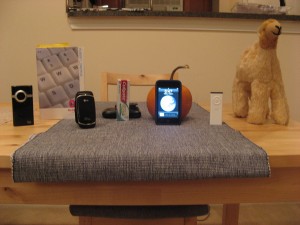
We are awash in information. We drowning in our communication channels. We have access to everything so we can process nothing. All is lost.
I don’t believe that. I imagine most of you don’t either. What I do wonder is how memory and cognition play in to discernment, that ability to identify and extract information from the noise. Does it have an upper limit?
Let me take stock of my own channels. Twitter (x2), Facebook (x2), Blog (x2), Google Alerts, Flickr, LinkedIn, even email. A fair amount of incoming data and these are mostly textual streams (except Flickr). Many more to include for other multimedia.
Each of these channels have their own natural modes of etiquette and rhythms. We enter these worlds, participate, and adhere to these cultures by abiding by them (to a point; utility still trumps cultural norms-I use Twitter as an instant messenger quite a bit). Despite the uniqueness of each channel, the multitude of tones across channels often blends to noise.
I immediately think of George Miller and the magic number 7. Miller’s “The Magical Number Seven, Plus or Minus Two: Some Limits on our Capacity for Processing Information“, published in 1956, espoused that general human memory is limited to remembering seven objects, plus or minus two. Miller himself was not sure if this was just coincidence or something to do with the regularity of the number seven in various constructs, but it does not matter.

We catalog information bearing this number in mind; website designers tend to not have more than seven options at any given juncture in an interface. In the United States, telephone numbers were exactly seven digits long for this purpose (sans area code).
Miller made allowances for chunking, that is putting objects or numbers in particular orders or grouped together to aid with association which in turn led to greater recall. Three is a likely chunk and social security numbers in the United States are a further example of chunking (123-456-789). Even with chunking, the social security numbers are within the +-seven calculation that Miller put forth.
Is this upper level of seven applicable to learning? Are there upper limits to the layering of learning? Are we limited by our senses, or some combination of sensory perception? Are seven channels (give or take two) enough or too much?
I suspect that the answer to this will depend on reconstituting these channels into a larger construct (a group project using different multimedia to create a presentation or report, for example). However, does this filtering process, this general discernment, sit with the student or the teacher? Won’t the teacher inherently gravitate towards some and avoid others and subsequently pass that along in their instruction?
If memory is limited to seven objects (plus or minus two) then is the amount of input itself limited to this number? If everything after seven is regulated to noise, can complexity in learning be truly represented?

